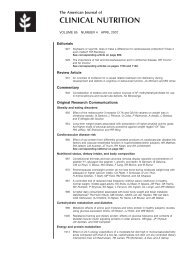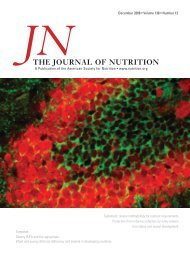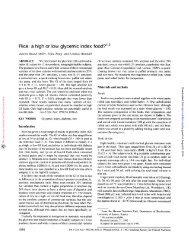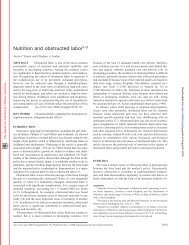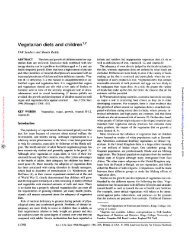Influence of Plane of Nutrition on Body Composition, Organ Size and ...
Influence of Plane of Nutrition on Body Composition, Organ Size and ...
Influence of Plane of Nutrition on Body Composition, Organ Size and ...
Create successful ePaper yourself
Turn your PDF publications into a flip-book with our unique Google optimized e-Paper software.
ENERGY UTILIZATION DURING REALIMENTATION 25271800 h. <strong>Body</strong> weights were taken twiceweekly. Daily feed intake <str<strong>on</strong>g>of</str<strong>on</strong>g> individual animals was adjusted twice weekly based <strong>on</strong>actual body weights <strong>and</strong> targeted weightssuch that the planned gains or losses wereachieved. A premeasured amount <str<strong>on</strong>g>of</str<strong>on</strong>g> feed(Purina Rat Chow) was given to each animal at 1600 h each day <strong>and</strong> unc<strong>on</strong>sumedfeed was removed at 0800 h the followingmorning. Weight <str<strong>on</strong>g>of</str<strong>on</strong>g> unc<strong>on</strong>sumed feed wasrecorded daily. All animals had free accessto water at all times.During period 2, total excreti<strong>on</strong> <str<strong>on</strong>g>of</str<strong>on</strong>g> urine<strong>and</strong> feces <str<strong>on</strong>g>of</str<strong>on</strong>g> 24 animals r<strong>and</strong>omly chosenacross the eight treatment groups was collected for 3 d for determinati<strong>on</strong> <str<strong>on</strong>g>of</str<strong>on</strong>g> the metabolizableenergy c<strong>on</strong>tent <str<strong>on</strong>g>of</str<strong>on</strong>g> the diet.Statistical analysis <str<strong>on</strong>g>of</str<strong>on</strong>g> the results did notreveal any significant differences due to sexor feeding level. Therefore a mean value <str<strong>on</strong>g>of</str<strong>on</strong>g>2.91 kcal/g was adopted as the metabolizableenergy c<strong>on</strong>tent <str<strong>on</strong>g>of</str<strong>on</strong>g> the diet forcalculati<strong>on</strong> <str<strong>on</strong>g>of</str<strong>on</strong>g> ME intakes.Data were analyzed by analysis <str<strong>on</strong>g>of</str<strong>on</strong>g>variance <strong>and</strong> regressi<strong>on</strong> procedures (22).The effect <str<strong>on</strong>g>of</str<strong>on</strong>g> sex <strong>on</strong> body compositi<strong>on</strong> traits<str<strong>on</strong>g>of</str<strong>on</strong>g> rats killed at the initiati<strong>on</strong> <str<strong>on</strong>g>of</str<strong>on</strong>g> the studywas evaluated by <strong>on</strong>e-way analysis <str<strong>on</strong>g>of</str<strong>on</strong>g>variance. The relati<strong>on</strong>ship between bodyprotein, body fat or energy c<strong>on</strong>tent <strong>and</strong>body weight was evaluated by use <str<strong>on</strong>g>of</str<strong>on</strong>g> amodel that included sex, body weight (BW,linear <strong>and</strong> quadratic) <strong>and</strong> all two-way interacti<strong>on</strong>s as independent variables. N<strong>on</strong>significant independent variables were deletedstepwise in subsequent analyses.The effects <str<strong>on</strong>g>of</str<strong>on</strong>g> sex <strong>and</strong> treatment duringperiod 1 <strong>on</strong> food c<strong>on</strong>sumpti<strong>on</strong>, bodyweight, body compositi<strong>on</strong>, rate <str<strong>on</strong>g>of</str<strong>on</strong>g> gain <strong>and</strong>compositi<strong>on</strong> <str<strong>on</strong>g>of</str<strong>on</strong>g> gain were evaluated by twowayanalysis; the model included treatment, sex <strong>and</strong> the two-way interacti<strong>on</strong> asindependent variables. Treatment groupmeans were compared by Student's f-test ifthe analysis <str<strong>on</strong>g>of</str<strong>on</strong>g> variance indicated significant treatment differences. The relati<strong>on</strong>ships between empty body weight, water,protein, fat, ash or energy <strong>and</strong> BW were determined by procedures like those describedabove.Data obtained during <strong>and</strong> at the end <str<strong>on</strong>g>of</str<strong>on</strong>g>period 2 were also analyzed by analysis <str<strong>on</strong>g>of</str<strong>on</strong>g>variance. The model includedsex <strong>and</strong> the two-way interacti<strong>on</strong>treatment,as independent variables. Student's i statistic was usedfor comparis<strong>on</strong> <str<strong>on</strong>g>of</str<strong>on</strong>g> specific means (i.e, rats<str<strong>on</strong>g>of</str<strong>on</strong>g> the same sex <strong>and</strong> final weight group or <str<strong>on</strong>g>of</str<strong>on</strong>g>the same sex <strong>and</strong> rate <str<strong>on</strong>g>of</str<strong>on</strong>g> gain during period2) if analysis <str<strong>on</strong>g>of</str<strong>on</strong>g> variance indicated significant (P < 0.05) treatment or sex x treatment effects. Multiple linear regressi<strong>on</strong>analyses were used to describe relati<strong>on</strong>ships<str<strong>on</strong>g>of</str<strong>on</strong>g> visceral organ weights to empty bodyweight <strong>and</strong> average daily weight gain during period 2. Sex <strong>and</strong> its two-way interacti<strong>on</strong>s were included as independentvariables to test sex effects <strong>on</strong> these relati<strong>on</strong>ships. The model proposed by Ko<strong>on</strong>g <strong>and</strong>Hill (22) was used to evaluate relati<strong>on</strong>ships<str<strong>on</strong>g>of</str<strong>on</strong>g> daily empty body energy gain (kilocalories)to average metabolic body size (kilograms empty body weight 0.75)<strong>and</strong> dailymetabolizable energy intake (kilocalories).Sex <strong>and</strong> previous nutriti<strong>on</strong>al treatment(treatment during period 1) as well as alltwo-way interacti<strong>on</strong>s were included in theinitial model to evaluate their effects <strong>on</strong>these relati<strong>on</strong>ships. Estimates <str<strong>on</strong>g>of</str<strong>on</strong>g>maintenance [metabolizable energy required for zero body energy change,kcal/(kg°75-d)3 were calculated from theresulting equati<strong>on</strong>s after setting energychange to zero.RESULTSWeight <strong>and</strong> compositi<strong>on</strong> <str<strong>on</strong>g>of</str<strong>on</strong>g> male <strong>and</strong>female rats killed at the initiati<strong>on</strong> <str<strong>on</strong>g>of</str<strong>on</strong>g> thestudy are presented in table 1. No significant differences (P > 0.10) between malesTABLE 1Least squares means for initial weight <strong>and</strong>compositi<strong>on</strong> <str<strong>on</strong>g>of</str<strong>on</strong>g> male <strong>and</strong> female ratsTrait Male FemaleRSD'No. animalsLiver <str<strong>on</strong>g>of</str<strong>on</strong>g>gEmptyweight,g<strong>Body</strong> body,g<strong>Body</strong>water,g<strong>Body</strong>fat,g<strong>Body</strong>protein,g<strong>Body</strong>ash,energy, kcal686.374.253.44.213.72.56120975.164.446.43.511.92.2910312.9712.078.'Calculatedas the square root <str<strong>on</strong>g>of</str<strong>on</strong>g> the error meansquare <strong>and</strong> based <strong>on</strong> 13 error degrees <str<strong>on</strong>g>of</str<strong>on</strong>g> freedom. St<strong>and</strong>ard error may be calculated as RSD/VNjDownloaded from jn.nutriti<strong>on</strong>.org by guest <strong>on</strong> August 9, 2014



